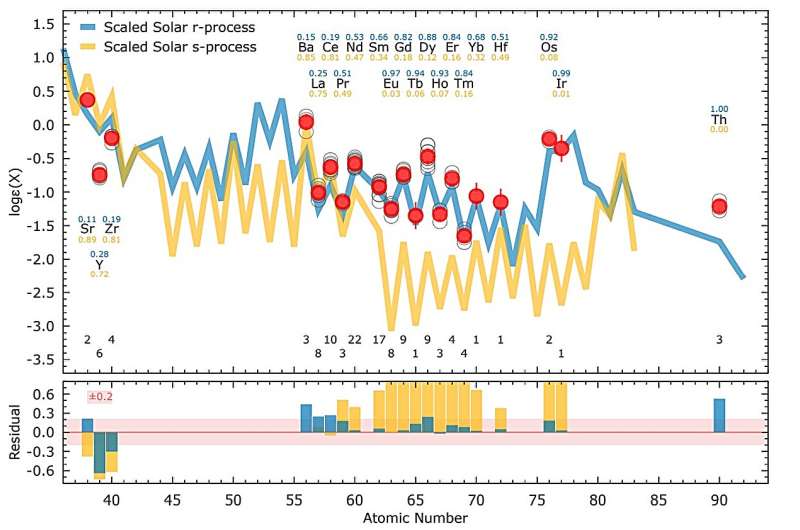October 31, 2023 report
This article has been reviewed according to Science X's editorial process and policies. Editors have highlighted the following attributes while ensuring the content's credibility:
fact-checked
preprint
trusted source
proofread
GHOST finds an extremely metal-poor star

An international team of astronomers reports the detection of a new extremely metal-poor star using the Gemini High-resolution Optical SpecTrograph (GHOST) at the Gemini South telescope in Chile. The finding was presented in a paper published October 25 on the pre-print server arXiv.
Metal-poor stars are rare objects as only a few thousands of stars with iron abundances [Fe/H] below -2.0 have been discovered to date. Expanding the still short list of metal-poor stars is of high importance for astronomers as such objects have the potential to improve our knowledge of chemical evolution of the universe.
Located some 25,500 light years away from the Earth, SPLUS J142445.34−254247.1, or SPLUS J1424−2542 for short, was detected in 2019 as part of the Southern Photometric Local Universe Survey (S-PLUS). The star has a mass of about 0.84 solar masses, is estimated to be 10 billion years old, and its effective temperature is approximately 4,750 K.
Previous studies of SPLUS J1424−2542 have suggested that its metallicity is at a level of -3.25, therefore it should be classified as an extremely metal-poor star.
Now, a group of astronomers led by Vinicius M. Placco of the University of São Paulo in Brazil, has conducted GHOST observations of SPLUS J1424−2542, which allowed them to perform a chemical study of this star confirming this hypothesis.
"High-resolution spectroscopy was gathered with GHOST at Gemini South, allowing for the determination of chemical abundances for 36 elements, from carbon to thorium," the researchers wrote in the paper.
The GHOST spectrum of SPLUS J1424−2542 allowed the team to detect 308 absorption features for 36 elements. The metallicity of this star was found to be approximately -3.39, which confirms its extremely metal-poor nature.
The study found that SPLUS J1424−2542 shows enhancement in heavy elements. This, together with its low metallicity and carbon to iron ratio at a level of 0.06, indicates that the star most likely was formed from a gas cloud polluted by at least two progenitor populations—the supernova explosion from a metal-free star (with an estimated mass of about 11.3–13.4 solar masses) and the aftermath of a binary neutron star merger with masses of about 1.66 and 1.27 solar masses.
The results suggest that SPLUS J1424−2542 has an effective temperature of 4,762 K, which is consistent with previous studies. The total space velocity of this star was calculated to be approximately 108 km/s.
Summing up the result, the authors of the paper concluded that SPLUS J1424−2542, besides being extremely metal-poor, is a low-mass, old star, which belongs to the in-situ Galactic halo population.
More information: Vinicius M. Placco et al, SPLUS J142445.34-254247.1: An R-Process Enhanced, Actinide-Boost, Extremely Metal-Poor star observed with GHOST, arXiv (2023). DOI: 10.48550/arxiv.2310.17024
Journal information: arXiv
© 2023 Science X Network





















